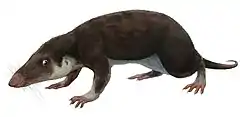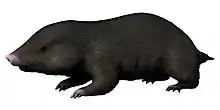| Cyrtlatherium Temporal range: Middle Jurassic, | |
|---|---|
| Scientific classification | |
| Domain: | Eukaryota |
| Kingdom: | Animalia |
| Phylum: | Chordata |
| Clade: | Synapsida |
| Clade: | Therapsida |
| Clade: | Cynodontia |
| Clade: | Mammaliaformes |
| Order: | †Docodonta |
| Family: | †Docodontidae |
| Genus: | †Cyrtlatherium Freeman, 1979 |
| Species: | †C. canei |
| Binomial name | |
| †Cyrtlatherium canei Freeman, 1979 | |
Cyrtlatherium is a dubious genus of extinct docodontan mammaliaform from the Middle Jurassic rocks of Oxfordshire, England. As it is only known from a few isolated molar teeth, there is disagreement about whether Cyrtlatherium is a separate genus, or whether it is a synonym and the molar teeth are the milk teeth of another genus of docodont.
Cyrtlatherium was named from a few single molar teeth found in the Kirtlington mammal beds in England, which were originally thought to belong to a kuehneotheriid,[1] but were later reclassified as belonging to a docodont.[2] When reclassifying it, Sigogneau-Russell argued that it was the milk tooth of a previously named docodont called Simpsonodon. This is now generally accepted to be the case by most mammal palaeontologists.
References
- ↑ Freeman EF. 1979. A Middle Jurassic mammal bed from Oxfordshire. Palaeontology 22:135-166
- ↑ Sigogneau-Russell D. 2001 Docodont nature of Cyrtlatherium, an upper Bathonian mammal from England. Acta Palaeontologica Polonica, 46:429-430





